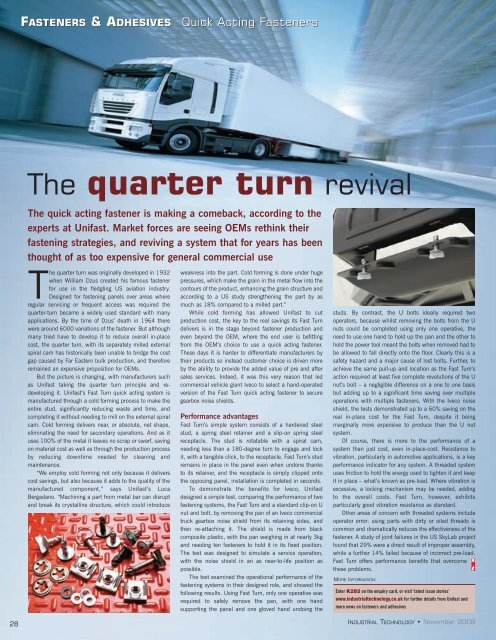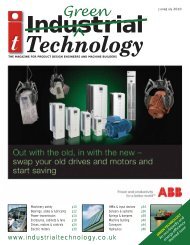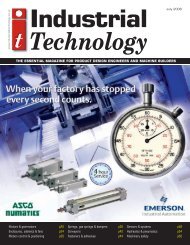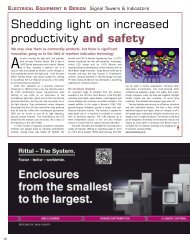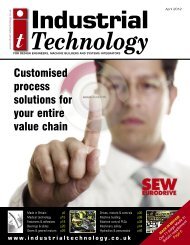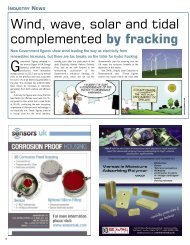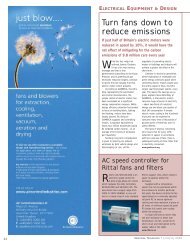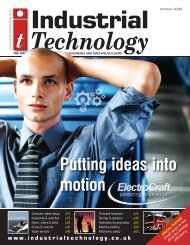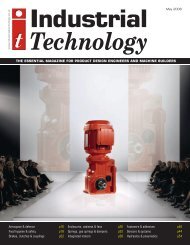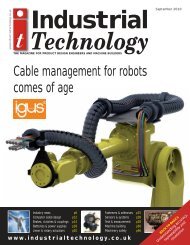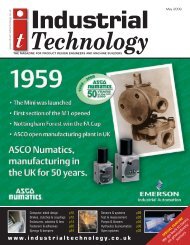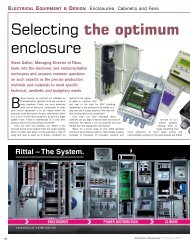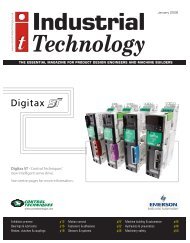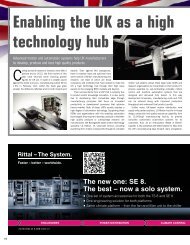machine building & automation - Industrial Technology Magazine
machine building & automation - Industrial Technology Magazine
machine building & automation - Industrial Technology Magazine
- No tags were found...
You also want an ePaper? Increase the reach of your titles
YUMPU automatically turns print PDFs into web optimized ePapers that Google loves.
FASTENERS & ADHESIVESQuick Acting FastenersThe quarter turn revivalThe quick acting fastener is making a comeback, according to theexperts at Unifast. Market forces are seeing OEMs rethink theirfastening strategies, and reviving a system that for years has beenthought of as too expensive for general commercial useThe quarter turn was originally developed in 1932when William Dzus created his famous fastenerfor use in the fledgling US aviation industry.Designed for fastening panels over areas whereregular servicing or frequent access was required thequarter-turn became a widely used standard with manyapplications. By the time of Dzus’ death in 1964 therewere around 6000 variations of the fastener. But althoughmany tried have to develop it to reduce overall in-placecost, the quarter turn, with its separately milled externalspiral cam has historically been unable to bridge the costgap caused by Far Eastern bulk production, and thereforeremained an expensive proposition for OEMs.But the picture is changing, with manufacturers suchas Unifast taking the quarter turn principle and redevelopingit. Unifast’s Fast Turn quick acting system ismanufactured through a cold forming process to make theentire stud, significantly reducing waste and time, andcompleting it without needing to mill on the external spiralcam. Cold forming delivers near, or absolute, net shape,eliminating the need for secondary operations. And as ituses 100% of the metal it leaves no scrap or swarf, savingon material cost as well as through the production processby reducing downtime needed for cleaning andmaintenance.“We employ cold forming not only because it deliverscost savings, but also because it adds to the quality of themanufactured component,” says Unifast’s LucaBergadano. “Machining a part from metal bar can disruptand break its crystalline structure, which could introduceweakness into the part. Cold forming is done under hugepressures, which make the grain in the metal flow into thecontours of the product, enhancing the grain structure andaccording to a US study strengthening the part by asmuch as 18% compared to a milled part.”While cold forming has allowed Unifast to cutproduction cost, the key to the real savings its Fast Turndelivers is in the stage beyond fastener production andeven beyond the OEM, where the end user is befittingfrom the OEM’s choice to use a quick acting fastener.These days it is harder to differentiate manufacturers bytheir products so instead customer choice is driven moreby the ability to provide the added value of pre and aftersales services. Indeed, it was this very reason that ledcommercial vehicle giant Iveco to select a hand-operatedversion of the Fast Turn quick acting fastener to securegearbox noise shields.Performance advantagesFast Turn’s simple system consists of a hardened steelstud, a spring steel retainer and a slip-on spring steelreceptacle. The stud is rotatable with a spiral cam,needing less than a 180-degree turn to engage and lockit, with a tangible click, to the receptacle. Fast Turn’s studremains in place in the panel even when undone thanksto its retainer, and the receptacle is simply clipped ontothe opposing panel, installation is completed in seconds.To demonstrate the benefits for Iveco, Unifastdesigned a simple test, comparing the performance of twofastening systems, the Fast Turn and a standard clip-on Unut and bolt, by removing the pan of an Iveco commercialtruck gearbox noise shield from its retaining sides, andthen re-attaching it. The shield is made from blackcomposite plastic, with the pan weighing in at nearly 3kgand needing ten fasteners to hold it in its fixed position.The test was designed to simulate a service operation,with the noise shield in an as near-to-life position aspossible.The test examined the operational performance of thefastening systems in their designed role, and showed thefollowing results. Using Fast Turn, only one operative wasrequired to safely remove the pan, with one handsupporting the panel and one gloved hand undoing thestuds. By contrast, the U bolts ideally required twooperators, because whilst removing the bolts from the Unuts could be completed using only one operative, theneed to use one hand to hold up the pan and the other tohold the power tool meant the bolts when removed had tobe allowed to fall directly onto the floor. Clearly this is asafety hazard and a major cause of lost bolts. Further, toachieve the same pull-up and location as the Fast Turn’saction required at least five complete revolutions of the Unut’s bolt – a negligible difference on a one to one basisbut adding up to a significant time saving over multipleoperations with multiple fasteners. With the Iveco noiseshield, the tests demonstrated up to a 60% saving on thereal in-place cost for the Fast Turn, despite it beingmarginally more expensive to produce than the U nutsystem.Of course, there is more to the performance of asystem than just cost, even in-place-cost. Resistance tovibration, particularly in automotive applications, is a keyperformance indicator for any system. A threaded systemuses friction to hold the energy used to tighten it and keepit in place – what’s known as pre-load. Where vibration isexcessive, a locking mechanism may be needed, addingto the overall costs. Fast Turn, however, exhibitsparticularly good vibration resistance as standard.Other areas of concern with threaded systems includeoperator error: using parts with dirty or oiled threads iscommon and dramatically reduces the effectiveness of thefastener. A study of joint failures in the US SkyLab projectfound that 29% were a direct result of improper assembly,while a further 14% failed because of incorrect pre-load.Fast Turn offers performance benefits that overcomethese problems.MORE INFORMATION:Enter K285 on the enquiry card, or visit ‘latest issue stories’www.industrialtechnology.co.uk for further details from Unifast andmore news on fasteners and adhesives28INDUSTRIAL TECHNOLOGY • November 2008


